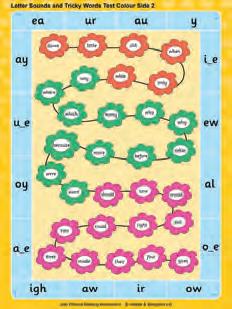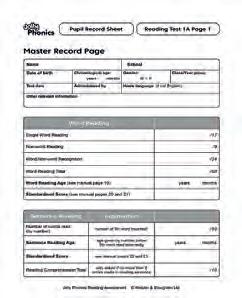Assess m ent Read i ng Assess m ent Read i ng





By formally assessing children, a greater understanding is obtained of how well they are progressing. It also provides the opportunity to identify any missing knowledge or skills. This is particularly vital when teaching reading.
Young children need a more child-friendly approach to assessment and testing. For this reason, the Jolly Phonics Reading Assessment is given in a one-to-one situation with an adult who is known to the child. The materials are colourful and take a relatively short time to administer. The children in the trials enjoyed the experience.
Reading is a complex skill that has two important elements to it, namely decoding and comprehension.
Decoding is the skill that enables children to read words that they have never read before. Once a word has been blended a few times it becomes known and can be read automatically. After that blending is only needed for words that have never, or hardly ever, been read before.
Most children, using systematic synthetic phonics, learn to read with few problems. However, even with synthetic phonics, some children find it exceptionally difficult and need careful monitoring and support. The Jolly Phonics Reading Assessment provides teachers and parents with useful formal assessments, which can give a greater insight into what has or has not been achieved. With this knowledge, intervention support can be more accurately addressed.
Comprehension is a natural process that evolves from speaking and listening. The level of comprehension, when children start school, will depend on many factors, such as mother tongue, the amount of conversations experienced, the number of stories read to the child, life experiences, home encouragement, natural intelligence etc. All these factors influence the development of vocabulary and the understanding of language.
It is worth remembering that comprehension increases greatly when children are fluent at reading. The children who can read easily tend to be those who read for pleasure and information. Our goal is to enable children to master decoding and reading as soon as possible. The longer a child has to struggle the more difficult it is to catch up.
This child-friendly assessment enables teachers to identify problems. By using this assessment it becomes clear whether a child’s reading difficulties are a decoding problem, a comprehension problem, or both.
Great care should be taken to avoid specifically teaching any of the words used in the test as this would invalidate the test results.
There are two Reading Tests:
• Word Reading
• Sentence Reading
Both Reading Tests are provided at two levels so progress can be measured over time. Reading Tests 1 are for use after one full year of Jolly Phonics, while Reading Tests 2 are for use after two full years.
In addition the tests are provided in two parallel versions, A and B, to enable reliable re-testing. Hence the tests are provided in four versions in all, 1A, 1B, 2A and 2B.
The results from these tests are recorded on the appropriate Pupil Record Sheet. These are provided as photocopy masters in four versions (1A, 1B, 2A and 2B). As a result, this pack provides all the material needed for continuous assessment.
• Letter Sounds and Tricky Words
This test is for children who do not score well on the Reading Tests above. It tests phonic knowledge and recognition of tricky words.
• Aural Comprehension
This test is for children who do not score well in the comprehension part of the Sentence Reading test above. It provides a further test of comprehension of spoken language.
The Letter Sounds and Tricky Words Test is provided in just one version. The Aural Comprehension Test is a supplement to the Sentence Reading Test and is provided in the same four versions (1A, 1B, 2A and 2B).
Both of these Supplementary Tests have Pupil Record Sheets. The Pupil Record Sheets are within the Manual and again are photocopy masters. The Aural Comprehension does not have any separate text materials and is administered just from the Pupil Record Sheets (pages 17 and 18 of this manual).
1. Manual
2. Word Reading and Sentence Reading Colour Sheets (12 x double-sided sheets, three for each version 1A, 1B, 2A and 2B)
3. Pupil Record Sheets (4 x photocopiable A3 folded sheets)
4. Letter Sounds and Tricky Words Assessment Colour Sheet (2 x double-sided sheet)




Is this dish long and thin?
Name School
Date of birth Chronological age: years months Gender: M / F Class/Year group
Test date Administered by Home language (if not English)
Other relevant information
Single Word Reading /25
Non-word Reading /9
Word/Non-word Recognition /16
Word Reading Total /50
Word Reading Age (see manual page 10) years months
Standardised Score (see manual pages 20 and 21)
Number of words read (by number) number of 5th word incorrect* /50
Sentence Reading Age age given by number below 5th word read incorrectly years months
Standardised Score see manual pages 22 and 23
Reading Comprehension Total only asked if no more than 2 errors made in reading sentence /10
Read the advice on administering the Word Reading Test on page 7 in the manual. Select the Single Word Reading, Non-word Reading and Word/Non-word Recognition coloured sheets. Start by asking the child to read the words on the Single Word Reading Sheet, Side 1. Write the number of words read correctly in the Total column on this sheet. Progress to the Non-word reading, which is on the other side of the coloured sheet. Ensure that the child understands that these words have no meaning and must be worked out by blending the letter sounds. Lastly ask the child to look at the first group of words on the coloured Word/Non-word Recognition sheet. Explain that there are groups of 5 words and that the child should point to the word that has been called out, after looking at all the words. The words to call out are on this sheet, with the non-words being written in italics. Count the words recognised correctly, record the total and transfer that to page 1, the Master Record Page.
Non-Word Reading
jaint bince knope lare saphine trief squalf blove Total
Word / Non-Word Recognition
shoat grain groon spade spode stour steer woid wide share shir champion chieftain liked imagination Total

Jolly Phonics Reading Assessment provides teachers and parents with a formal measure of a child’s reading ability. The results can be used to decide whether intervention support is needed. The tests cover word reading, sentence reading and reading comprehension and are administered one-to-one. They are designed for children who have had one year of full time teaching, with follow up tests to monitor progress a year later. They take a relatively short time to administer. The colourful materials and personal attention make these tests very suitable and popular with young children.



 Developed by Colin McCarty and Kate Ruttle © 2012 Hodder & Stoughton Ltd
Developed by Colin McCarty and Kate Ruttle © 2012 Hodder & Stoughton Ltd


Adapted by Sue Lloyd and Christopher Jolly
& Edited by Caroline Petherbridge
by Lydia Bennett